7 /10 1 Votes7
5/10 IGN | 4.4/5 Emuparadise Initial release date 27 August 1997 Designer Parker A. Davis | |||||||||||||||||||||||||||||||||
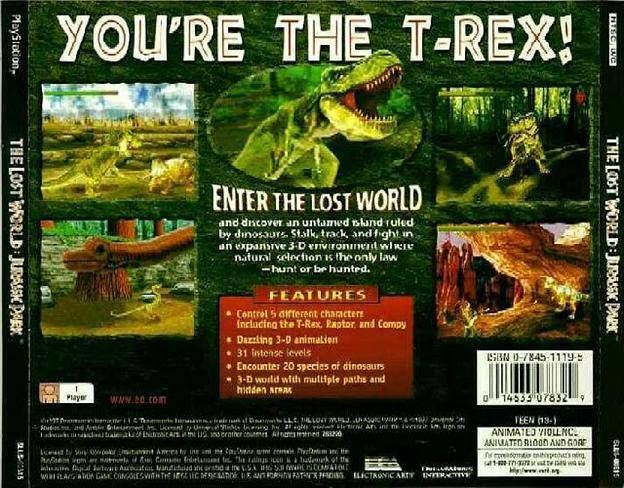 | ||||||||||||||||||||||||||||||||||
Similar Warpath: Jurassic Park, Jurassic Park, Jurassic Park: The Game, Jurassic Park 2: The Chaos C, Jurassic Park: Rampage | ||||||||||||||||||||||||||||||||||
The Lost World: Jurassic Park is an action-adventure video game developed by DreamWorks Interactive and Appaloosa Interactive, and published by Electronic Arts and Sega for the Sony PlayStation and Sega Saturn, respectively, in 1997. The Lost World: Jurassic Park is based on the film of the same name, which in turn is based on the novel by Michael Crichton. In 1998 a special edition of the game was released for the Sony PlayStation as a Greatest Hits title and featured several modifications to the gameplay.
Contents

Gameplay
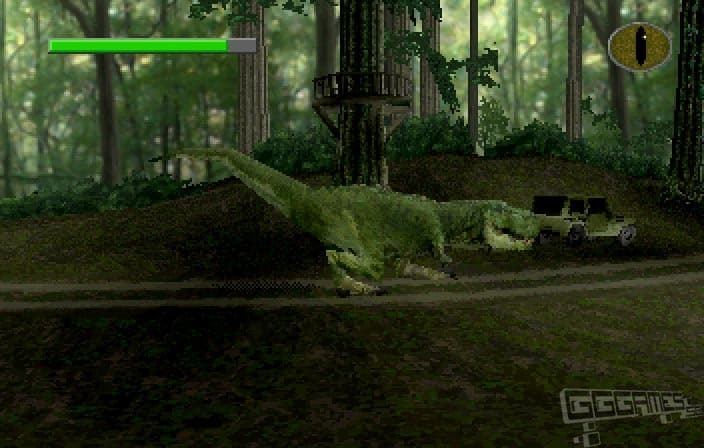
The Saturn and PlayStation versions feature identical gameplay. The game features a side-scroller perspective. There are 5 characters in all throughout the course of the game, each with their own special abilities and attributes: Compsognathus, Human Hunter, Velociraptor, Tyrannosaurus rex, and Sarah Harding, who is also known as the "Human Prey". During gameplay, the character must complete all levels to sequentially gain access to the next character. For each character, there are "DNA bonuses" in each level that can be collected for access to storyboard art for that particular character. If every bonus is gained a secret ending to the game will be accessible. The secret ending is a video of Jeff Goldblum as Ian Malcolm congratulating but urging the player to stop playing and go outside.
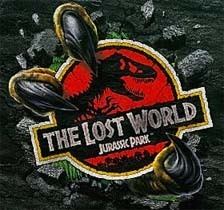
The Lost World: Jurassic Park ignores the plot of the film, despite featuring some of its dinosaurs and being set on "Site B", an island also known as Isla Sorna and used as InGen's dinosaur breeding site. The plot varies with every character, each one struggling to survive on the island, populated by over 20 species of dinosaurs in an environment of escalating chaos.
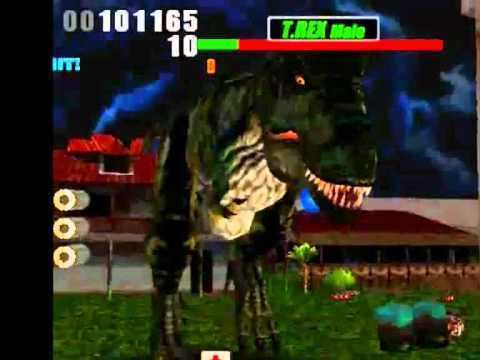
The playable dinosaurs' chapters consist of traversing various parts of the island, defending against other predators as well as InGen hunters. The "Human Hunter" chapters are largely based in more urban environments including an underground complex, a geothermal center and an InGen lab. Although objectives are never elaborated on, the Hunter's goal is to eliminate any dinosaur threat. The final chapters involve Harding escaping the island on a cargo ship.
Development
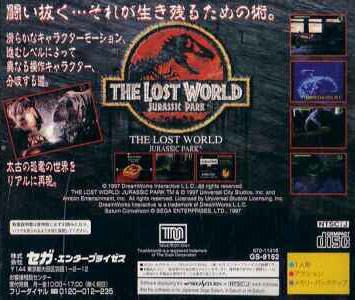
In March 1997, Electronic Arts announced that it had secured the distribution and publishing rights for a PlayStation video game adaptation of the film, as part of a deal with DreamWorks. During the first two months of pre-production, producer Patrick Gilmore held daily meetings with his development team to develop a variety of ideas for the game. The ideas were ultimately put into a concept document that included more than 100 pages, some of which offered storyboards and detailed descriptions of each scene in the game.
Concept artist Matt Hall created each of the game's creatures using skeletal references, saying, "I wanted to make sure everything could be backed up by the latest scientific theories regarding posture and musculature. When selecting color, I had much more freedom, but an effort was made to study natural color patterns of animals which exist today." The creatures' designs were based on computer-generated models created for the film by Industrial Light & Magic. Creature designs were also based on photographs of dinosaur maquettes that were created by artist Stan Winston for the film. 3D creatures were then created as low polygon models combined with Hall's sketches.
The movements of the game's T. rex, raptor, and Brachiosaurus were based on movements featured in the original film, Jurassic Park. The game's animation team visited the Los Angeles Zoo multiple times and watched nature programs to study the movement of modern animals as research for how to animate other creatures that did not appear in the films.
The game was created with DreamWorks Interactive's Morf-X game engine. The development team had access to pre-production materials from the film, as well as models and sets. Spielberg also offered his input on the game.
Bryan Franklin and Erik Kraber of Franklin Media worked on the game's sound effects; they had previously created sound effects for Jurassic Park: The Online Adventure and Jurassic Park: The Ride. The creature sound effects were created using thousands of animal noises, such as beluga whale songs, vermilion flycatcher clicks, and the grunts of baby jaguars, as well as humans blowing through a 12-foot vacuum tube. A total of 1,400 sounds were created for the game's 23 creatures and two human characters, as well as other elements of the game. Sound effects were altered in multiple ways to create the creatures' various noises.
Soundtrack
The Lost World: Jurassic Park is notable for being the first video game to feature a fully orchestrated soundtrack. The music was composed by Michael Giacchino who was hired by DreamWorks Interactive to create a synth score to show to the game's producer Steven Spielberg. Spielberg was impressed by his music and to the surprise of everyone involved he assumed it would be fully orchestrated.
Giacchino was given a book of the game's storyboards to aid in the musical composition. Giacchino worked on the score for six months while the game was in development. The music was created during a two-day recording session with a 40-piece orchestra, and was subsequently mixed at a post-production house in Hollywood, California. The soundtrack was edited to include 19 tracks, with a total duration of 45 minutes. Giacchino gave each playable character a brief theme to reflect their personality and purpose. After hearing the soundtrack, Spielberg called Giacchino "a young John Williams."
Reviewers expressed so much enthusiasm for playing a game with a live orchestral soundtrack that DreamWorks would get Giacchino to use an orchestra for his later scores for the Medal of Honor games. The soundtrack can be played by inserting the game disc into a CD player. The Lost World: Jurassic Park's soundtrack was released separately on CD by Sonic Images on February 24, 1998.
Reception
The Lost World: Jurassic Park was released mixed to negative reviews, it currently holds a score of 59.67% on GameRankings. Multiple critics noted that the game suffered from poor control, incredibly high difficulty, and a lack of a save function. Additionally, GameSpot commented regarding the T. rex as a playable character, "on the back of the game's box it says in really big letters: "You're The T-Rex." The whole truth is you only get to be the T-Rex for seven of the 30 levels."
Despite the negative reviews there were a number of elements in the game that received praise. The Lost World: Jurassic Park was one of the first games to feature a full orchestral soundtrack recorded specifically for the game, noted by critics as a high point in the game. The sound design was also well received, with GameSpot even stating that it was "definitely one of the few reasons you will enjoy playing The Lost World". Many also agreed that the in-game graphics were some of the best available upon its release. The dinosaurs in particular were considered to be highly lifelike with Game Revolution stating that "despite the game's many problems, every PlayStation owner should rent the game just to experience its graphics". Lee Nutter of Sega Saturn Magazine gave the Saturn version a 60 percent rating out of 100 and criticized its poor controls, bad graphics, and difficulty of certain levels, but praised its orchestral soundtrack as "one of the very few redeeming features" of the game.
Special Edition
On September 23, 1998, the game was released for the Sony PlayStation under the Greatest Hits banner as The Lost World: Jurassic Park - Special Edition. Unlike most greatest hits releases this was not a straight repackaging of the original game. Instead the Special Edition featured several modifications to the gameplay designed to address concerns raised by critics on the games initial release. Several of the game's mechanics that were modified included the difficulty level with mid level checkpoints, stronger player characters, and the inclusion of level select codes in the manual.
The Special Edition also featured an additional level that allowed players to play as the T. rex much earlier than before.
Other versions
A number of other games were released under the title The Lost World: Jurassic Park for other systems, as well as an arcade game and a pinball game. These games were developed separately by different companies and featured completely different gameplay styles.
